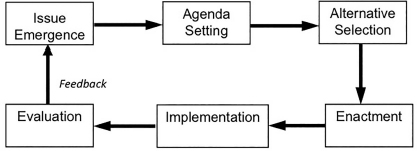Main Content
Lesson 2 : The Policy Making System, History and Structure of Policy Making in the United States
Stages Model
We briefly mentioned in the previous lesson that the policy process can be described as sequential stages in which a public policy is made. This way of understanding the policy process is known as the “stages model.”
The stages model, introduced by Lasswell (1956), is one of the two earliest models that is still used in public policy studies and policy analysis. Originally the stages model was described by Lasswell in seven stages. Later, some scholars combined or divided the original stages model, and proposed variations of the model. Bikalnd (2020), the author of the course textbook, proposed the following variation of the model (see Figure 2.1).

The stages model assumes that the policy process is relatively stable, ordered, and open. The subsequent models discussed here are responses to the stages model, either attempts to expand it in more analytic detail or critiques of its basic approach and assumptions.
First, a word about each stage in the model (later lessons will examine the nature of each stage in more detail):
- The first step is issue emergence. This stage is important to consider, because a standard view is that policy discussion would not begin unless there was a problem identified as appropriate for the government to address and substantial enough to warrant action.
- The second stage is agenda-setting. This approach focuses on how certain problems get on the government agenda for discussion and occasionally on solutions being considered.
- Alternative selection is the stage at which specific solutions are developed, debated, and researched.
- Enactment is the point at which decision-makers formally decide to adopt a particular policy.
- Once a policy is approved, it normally does not automatically go into operation. The program must be put into effect (the implementation phase). This might call for training employees, constructing facilities, purchasing technology, and so on.
- Once a program has been in effect for an appropriate length of time, it should be evaluated. Here, the goal is to see what the effects of the program are (whether or not it is "solving" the problem) and to see if there are any unanticipated consequences (good or bad). Based on the evaluation, changes to or termination of the program may be considered.
The stages model is a good conceptual tool because it provides a systematic policy process (Lasswell, 1971). But it should be used with some caution.
The stages should not be regarded as independent of each other. Each stage has an impact on the others. Stages can overlap (e.g. implementation and evaluation). It also suggests that there is an orderly progresion from one stage to the next, but in real-life policy processes, stages can be skipped and/or they may be done out of order.
Also, the stages model implies that there is a beginning and an end in a policy process, but the process is actually endless cycle.
References
Birkland, Birkland, T. A. (2020). An Introduction to the Policy Process (5th ed.). New York, NY: Routledge.
Lasswell, H. D. (1956). The decision process: Seven categories of functional analysis. College Park, MD: Bureau of Governmental Research of University of Maryland, College Park.
Lasswell, H. D. (1971). A Pre-View of Policy Sciences. New York: Elsevier Publishing Company.
